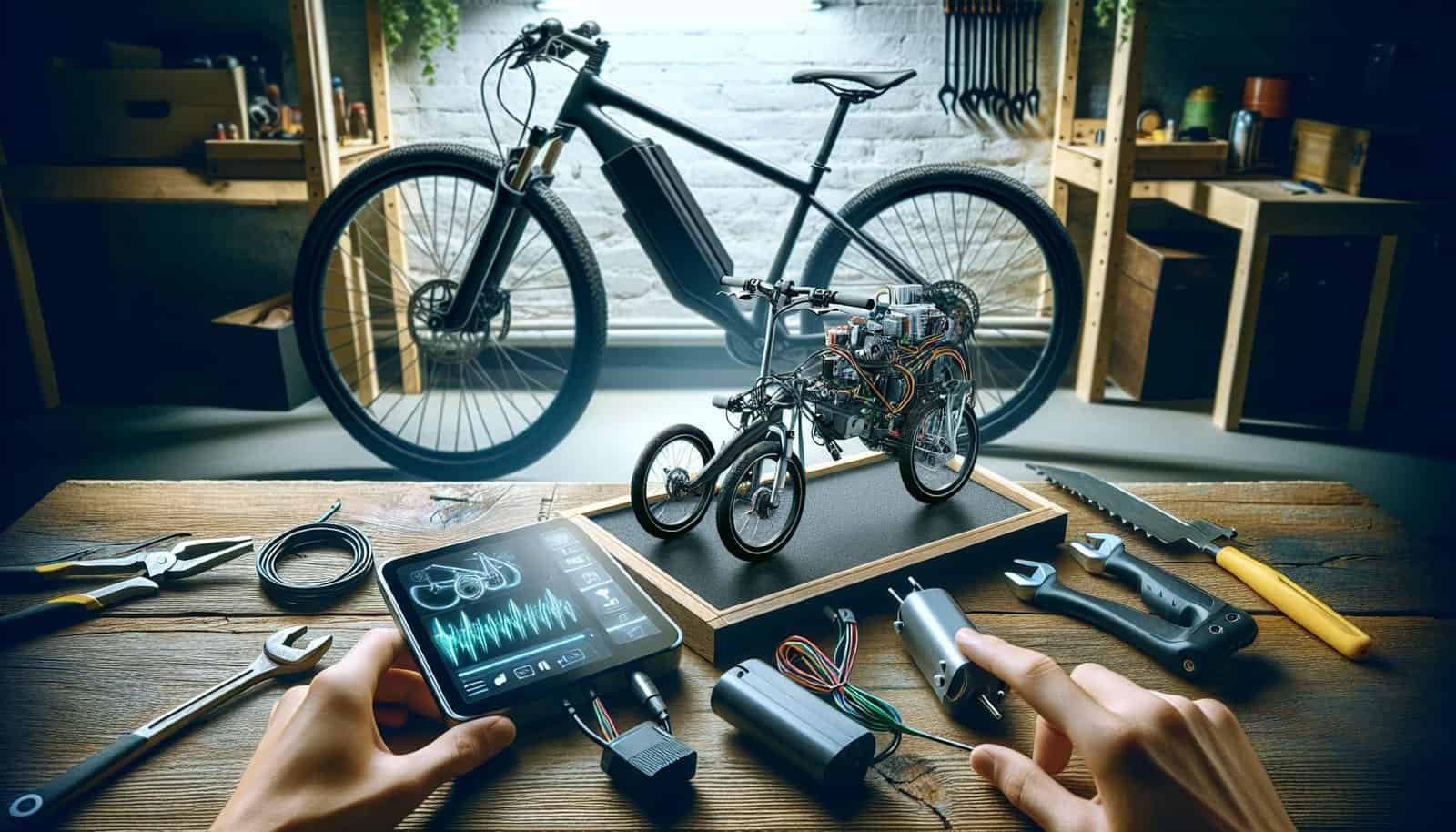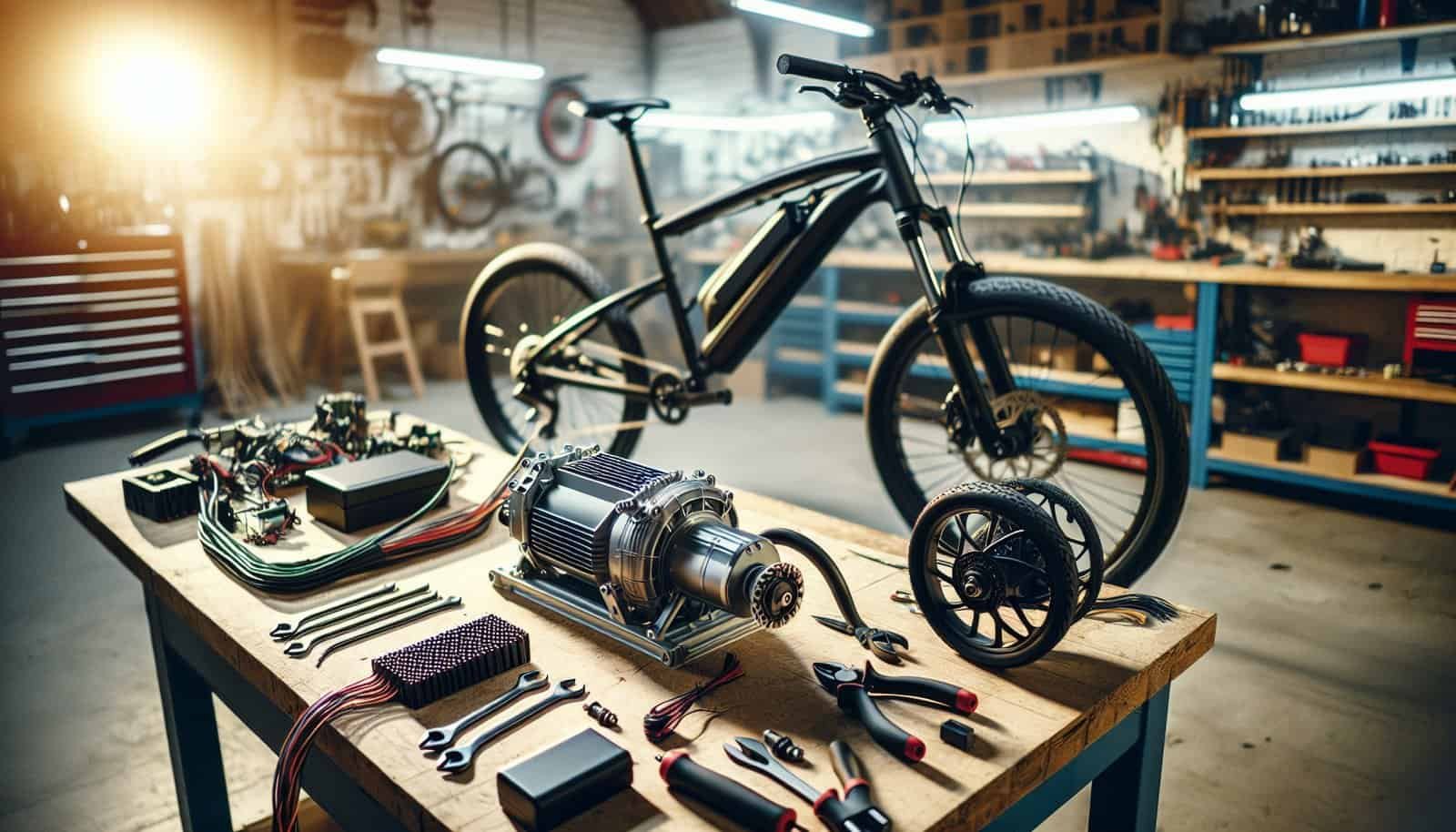Have you ever wondered if it’s possible to turn your trusty bicycle into an electric bike? Well, the answer is yes! With the help of a conversion kit, you can transform your existing bike into an electric-powered mode of transportation. Whether you’re looking to add a little extra oomph to your daily commute or simply want to explore new horizons, converting your bike into an electric bike opens up a world of possibilities. In this article, we’ll explore the ins and outs of conversion kits and discover how they can revolutionize your cycling experience. Get ready to take your biking adventures to a whole new level!
What is a conversion kit?
Definition of a conversion kit
A conversion kit is a set of components that allows you to transform your existing bike into an electric bike. It typically includes a motor, battery, controller, wiring, and other necessary accessories. By installing a conversion kit, you can enjoy the benefits of an electric bike without having to purchase a completely new one.
Components of a conversion kit
A typical conversion kit consists of several key components:
Motor: The motor is the heart of the conversion kit. It provides the power to assist your pedaling and propel the bike forward.
Battery: The battery stores the energy required to power the motor. It is usually mounted on the frame or carried in a bag attached to the bike.
Controller: The controller acts as the brain of the system, regulating the flow of electricity from the battery to the motor.
Wiring: The wiring connects the various components of the conversion kit, allowing them to communicate and function together.
Accessories: Depending on the specific conversion kit, additional accessories such as a throttle, display panel, or sensor may be included.
Types of conversion kits
There are different types of conversion kits available in the market, catering to various types of bikes and rider preferences. Some common types include:
Front-wheel conversion kit: This type of kit replaces the front wheel of your bike with a motorized wheel, providing propulsion through the front tire.
Rear-wheel conversion kit: Similar to the front-wheel kit, this option replaces the rear wheel with a motorized wheel for propulsion.
Mid-drive conversion kit: A mid-drive kit integrates the motor into the bike’s drivetrain, usually replacing the bottom bracket, enabling a more efficient power transfer.
All-in-one conversion kit: All-in-one kits include all the necessary components in a single package, making the installation process more straightforward.
Custom conversion kit: For those seeking specific components or features, custom conversion kits allow for a personalized electric bike transformation.
It’s important to choose a conversion kit that is compatible with your bike and meets your specific needs and preferences.
Benefits of converting your bike into an electric bike
Cost-effectiveness
Converting your existing bike into an electric bike can be a cost-effective alternative to purchasing a brand new electric bike. Since you already have a bike, you can save money by only investing in the conversion kit. Additionally, maintenance and repair costs for electric bikes are often comparable to regular bikes, making them a more affordable long-term transportation option.
Eco-friendly transportation
By converting your bike into an electric bike, you contribute to a more sustainable and eco-friendly mode of transportation. Electric bikes produce zero emissions during operation, reducing your carbon footprint and helping to combat air pollution. With the growing focus on environmentally-friendly transportation options, an electric bike conversion allows you to be part of the solution.
Retaining the familiarity of your existing bike
One of the advantages of converting your bike into an electric bike is that you can retain the familiarity of your existing bike. You don’t have to adjust to a new bike frame or learn how to handle different controls or settings. The conversion kit simply enhances your bike with electric assistance, making it easier to pedal and extending your range without drastically altering your riding experience.
Increased flexibility and versatility
Converting your bike into an electric bike increases your flexibility and versatility when it comes to commuting, running errands, or exploring new routes. Electric assistance enables you to tackle longer distances or steeper hills with ease, opening up a wider range of destinations and reducing the strain on your body. Whether you’re commuting to work or embarking on a weekend adventure, an electric bike conversion allows you to go further and enjoy your rides to the fullest.

Considerations before converting your bike
Compatibility of the bike frame
Before proceeding with a conversion, it’s important to ensure that your bike frame is compatible with the conversion kit. Different kits may have specific requirements in terms of frame size, geometry, and material. Most conversion kits are designed to fit standard bike frames, but it’s always a good idea to check with the manufacturer or consult a professional if you have any doubts.
Ensure proper fit of the conversion kit
To ensure the best performance and safety, it’s crucial to properly fit the conversion kit to your bike. This includes choosing the correct wheel size, motor type, and battery mounting location. A poorly fitted conversion kit could affect the bike’s stability, handling, and overall performance. Take the time to carefully follow the manufacturer’s instructions and seek assistance if needed.
Assessing the weight capacity of your bike
Electric bike conversion kits add additional weight to your bike, primarily through the motor and battery. It’s important to assess the weight capacity of your bike and ensure that it can safely withstand the added weight. Overloading your bike can lead to structural damage, reduced handling, and increased wear and tear on components. Refer to your bike’s manufacturer guidelines or consult a professional if you’re unsure about the weight capacity.
Availability of space for the battery and controller
Conversion kits require space to mount the battery and controller. Depending on your bike’s frame design, you may need to consider the availability of suitable mounting locations. Some conversion kits provide different mounting options to accommodate various frame configurations. It’s essential to ensure that your bike has enough space to properly install and secure these components without interfering with other parts or affecting its functionality.
Consideration of legal requirements
Electric bikes are subject to specific legal requirements in many jurisdictions. Before converting your bike, research and familiarize yourself with the regulations governing electric bikes in your area. This includes understanding the maximum speed limit, power output restrictions, and whether any additional permits or licenses are required. Adhering to local laws ensures a safe and legal riding experience.
Choosing the right conversion kit
Assessing power and range
When choosing a conversion kit, it’s important to assess the power and range requirements that best suit your needs. Consider factors such as the terrain you’ll be riding on, the distance you plan to cover, and the level of assistance you desire. Conversion kits come with different power ratings and battery capacities, so it’s crucial to choose one that will provide adequate power and range for your intended use.
Selecting the appropriate motor type
Conversion kits offer various motor types, including hub motors and mid-drive motors. Hub motors are typically easier to install and maintain, while mid-drive motors provide a more integrated riding experience and better hill-climbing capability. Consider your riding preferences, the terrain you’ll encounter, and the level of assistance you require when selecting a motor type.
Considering battery capacity and charging time
Battery capacity determines how far you can ride on a single charge, so it’s important to consider your average riding distance and the availability of charging points. Conversion kits come with batteries of different capacities, and larger capacity batteries generally offer longer ranges but may have longer charging times. Assess your riding needs and charging options to choose a battery that suits your lifestyle.
Evaluating the quality of components
Conversion kits can vary in terms of component quality, durability, and reliability. It’s advisable to choose a conversion kit from a reputable manufacturer that uses high-quality components. Read reviews, research the manufacturer, and look for warranties or customer support options. Investing in a reliable and durable conversion kit ensures a better riding experience and reduces the likelihood of premature component failure.
Comparing prices and warranties
Price is an important factor to consider when choosing a conversion kit, but it shouldn’t be the sole determining factor. Compare prices from different manufacturers, taking into account the overall value, quality, and features offered by each kit. In addition to price, consider the warranty provided by the manufacturer. A longer warranty indicates confidence in the product’s quality and can provide peace of mind in case of any issues or defects.

Tools and equipment required for the conversion
Basic hand tools
To successfully convert your bike, you will need a set of basic hand tools. This typically includes wrenches, screwdrivers, pliers, and Allen keys. These tools are essential for removing and installing various bike components.
Bike repair stand
A bike repair stand is highly recommended for easier access and stability during the conversion process. It allows you to suspend your bike off the ground, making it easier to work on various parts and reducing strain on your back.
Electrical tape and wire connectors
Electrical tape and wire connectors are necessary for properly securing and insulating electrical connections during the conversion. These help prevent short circuits and ensure reliable electrical connections.
Hex wrench set
A set of hex wrenches, also known as Allen wrenches, is essential for adjusting and securing bolts and screws used in the conversion kit. Different sizes may be required, so having a complete set is beneficial.
Zip ties
Zip ties are useful for organizing and securing loose wires and cables during the conversion process. They help keep everything neat and prevent potential entanglements or damage to the wiring.
Multimeter
A multimeter is a handy tool for troubleshooting electrical issues during and after the conversion. It allows you to measure voltage, current, and resistance, helping you diagnose and solve any potential problems.
Step-by-step process of converting your bike
Gathering all necessary tools and equipment
Before starting the conversion process, gather all the necessary tools and equipment mentioned above. This ensures that you have everything you need to complete the conversion without interruptions.
Preparing the bike for conversion
Start by cleaning and inspecting your bike to ensure that it’s in good overall condition. Remove any accessories or components that may interfere with the installation of the conversion kit, such as fenders or racks. Take note of the existing drivetrain, wheels, and brakes, as they may need adjustments to accommodate the conversion kit.
Installing the motor and battery
Refer to the manufacturer’s instructions for the specific steps to install the motor and battery. This typically involves removing the existing wheel and replacing it with the motorized wheel, ensuring proper alignment and securing it with the necessary bolts or quick-release mechanisms. Mount the battery in the specified location, considering weight distribution and stability.
Connecting the wiring and controller
Carefully connect the wiring harnesses provided by the conversion kit to the motor, battery, and controller according to the manufacturer’s instructions. Take extra care to ensure proper insulation and secure connections. Avoid pinching or damaging the wires during installation.
Testing and troubleshooting
Once all the connections are made, double-check all the wiring and components for proper installation. Turn on the controller and test the electrical system to ensure that the motor and other components are functioning correctly. Troubleshoot any issues that arise, referring to the manufacturer’s troubleshooting guide or seeking assistance if needed.
Securing all components
After successful testing and troubleshooting, secure all the components in their designated positions. Use zip ties or Velcro straps to neatly organize and secure the wiring. Ensure that all bolts and screws are tightened to the manufacturer’s specifications, paying extra attention to the motor and battery mounts.

Maintenance and troubleshooting
Regular cleaning and inspection
Just like any other bike, regular cleaning and inspection are essential for maintaining an electric bike. Keep the bike clean by washing off dirt and grime regularly. Inspect the frame, components, and electrical connections for any signs of wear, damage, or loose connections. Regular cleaning and inspection help identify and address potential issues before they become significant problems.
Battery maintenance and charging
Proper battery maintenance is crucial for ensuring optimal performance and longevity. Follow the manufacturer’s instructions to safely charge the battery and avoid overcharging or deep discharging. Keep the battery clean and dry, and avoid exposing it to extreme temperatures or moisture. Regularly check the battery’s charge level and recharge it as needed.
Motor and controller troubleshooting
If you encounter any issues with the motor or controller, consult the manufacturer’s troubleshooting guide or seek professional assistance. Avoid attempting any repairs or modifications unless you have the necessary knowledge and skills. Improper handling or tampering with the motor or controller can void warranties and cause further damage.
Addressing common issues
Electric bikes may experience common issues such as intermittent power, reduced range, or unusual noises. These can often be resolved by checking and tightening electrical connections, inspecting the drivetrain, and adjusting any misaligned components. Refer to the manufacturer’s manual or contact customer support to address specific issues that may arise.
Seeking professional assistance if needed
If you’re unsure about any maintenance or troubleshooting tasks, or if you encounter more complex issues, it’s recommended to seek professional assistance. Electric bike specialists or bike mechanics with experience in electric bike conversions can provide expert guidance and ensure that your bike is properly maintained and repaired.
Safety considerations
Wearing appropriate safety gear
When riding an electric bike, it’s important to wear appropriate safety gear. This includes a properly fitted helmet, reflective clothing, and gloves. Consider additional protective gear such as knee and elbow pads, particularly if you plan to ride in more challenging or off-road conditions.
Understanding the capability and limitations of your electric bike
Every electric bike has its own set of capabilities and limitations. Familiarize yourself with the performance characteristics of your electric bike, such as the maximum speed and range, and ride accordingly. Be aware of the increased weight and potential changes in handling dynamics compared to a regular bike.
Adhering to traffic laws and regulations
Electric bikes are subject to the same traffic laws and regulations as regular bikes in most jurisdictions. Follow all traffic rules, including speed limits, signaling, and yielding. Be aware of any local bike lane regulations or restrictions that may apply to electric bikes.
Ensuring proper maintenance and inspection
Regular maintenance and inspection are essential for keeping your electric bike in safe operating condition. Ensure that all components, including brakes, tires, and lights, are properly maintained and functioning correctly. Regularly inspect and adjust the electrical connections, and address any signs of wear or damage promptly.

Frequently Asked Questions (FAQs)
Can any bike be converted into an electric bike?
Most traditional bikes can be converted into an electric bike using a conversion kit. However, it’s important to ensure that your bike’s frame is compatible with the conversion kit and can handle the additional weight of the motor and battery. Consult the manufacturer’s guidelines or seek professional advice if you have any doubts.
Is it difficult to convert a bike into an electric bike?
The difficulty of converting a bike into an electric bike depends on your mechanical skills and familiarity with bike components. With basic knowledge and the right tools, the conversion process can be relatively straightforward. However, if you’re unsure or lack experience, it’s advisable to seek assistance from a professional or a knowledgeable bike mechanic.
How long does it take to convert a bike?
The time required to convert a bike into an electric bike varies depending on several factors, including your mechanical skills, the complexity of the conversion kit, and the condition of your bike. The process can take anywhere from a few hours to a full day. Take your time to ensure the conversion is done correctly and test all components thoroughly before riding.
What are the legal requirements for electric bikes?
The legal requirements for electric bikes vary between countries and regions. Common regulations typically include a maximum speed limit, power output restrictions, and the classification of electric bikes based on their capabilities. Check your local regulations to understand the specific legal requirements that apply to your electric bike.
Can I still use my bike as a regular bike after converting it?
Yes, converting your bike into an electric bike does not eliminate its ability to function as a regular bike. You can still pedal and ride your bike like you would without the electric assist. This flexibility allows you to choose between using electric assistance when needed or enjoying a more traditional biking experience.
Conclusion
Converting your existing bike into an electric bike using a conversion kit is a cost-effective way to enjoy the benefits of electric transportation. By choosing the right conversion kit, adhering to proper installation techniques, and maintaining your electric bike regularly, you can experience enhanced performance, increased range, and a more enjoyable riding experience. Remember to prioritize safety, understand the legal requirements, and exercise proper maintenance to ensure the longevity and optimal functioning of your electric bike. Happy riding!


